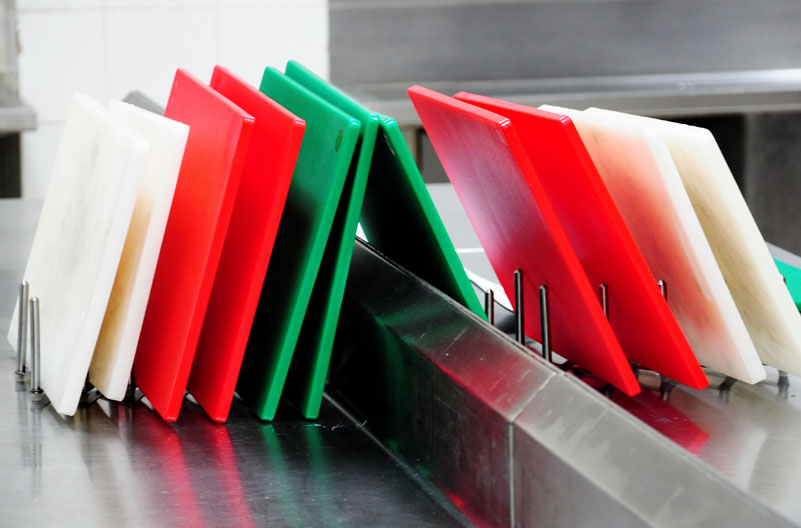Are coloured chopping boards a thing of the past?


Red for meat, white for bread, green for vegetables.... or is it yellow? Or is that for cooked meat? Coloured chopping boards can be a great way of reducing cross contamination but they depend on everyone remembering the system and sticking to it.
The principle behind coloured chopping boards is that foods that run the risk of carrying pathogenic bacteria are kept away from those that don't. Raw meats and fish are high risk food. They may carry low levels of bacteria even before they enter your kitchen, so it is important that any surface and utensils you use for these foods are cleaned and disinfected BEFORE they are used for other foods. This is where a coloured chopping board can be useful - but only if everyone knows that red boards are for raw meats and blue for raw fish - and thorough cleaning and disinfection is still vital in between uses.
Cooked meats, cheeses and ready to eat chilled foods are also high risk foods, as they are high in protein and moisture and are an ideal breeding ground for bacteria in the wrong conditions. Traditionally, cooked meats would be chopped on yellow boards, and cheese on a white board, alongside bakery - but here is another flaw in the process; if not kept safely, cheese may contain bacteria such as Listeria monocytogenes, Staphylococcus aureus, Escherichia coli, or Salmonella enterica, therefore using an unwashed chopping board for both bread and cheese runs a risk of cross contamination.
A relatively new addition to the world of coloured chopping boards is the purple board, for allergens. Again, this is a really tricky area. Using a separate board for allergenic ingredients can help ensure that they don't find their way into 'allergen free' dishes - but it doesn't guarantee that traces of one allergen doesn't contaminate dishes containing a different stated allergen. And don't forget that some allergens can become airborne - a purple chopping board is not an effective safeguard against peanut dust circulating throughout your kitchen.
In summary, coloured chopping boards can be an extra safeguard against cross contamination, as long as your system is understood and followed by every member of your kitchen team. But be careful they don't lead to complacent working practices or a replacement for thorough washing and disinfection between uses.
Need more information about introducing safe practices into your kitchen? Have a look at our Level 2 Food Hygiene, Level 2 HACCP and Level 3 Food Safety (Supervisors) courses today.
Join 950,000+ learners
Explore our award winning online video based training
The Safer Food Group
Unit 2, Integrity House,
Lower Lumsdale, Matlock
DE4 5EX
Back
to top
© The Safer Food Group 2025 | Privacy policy